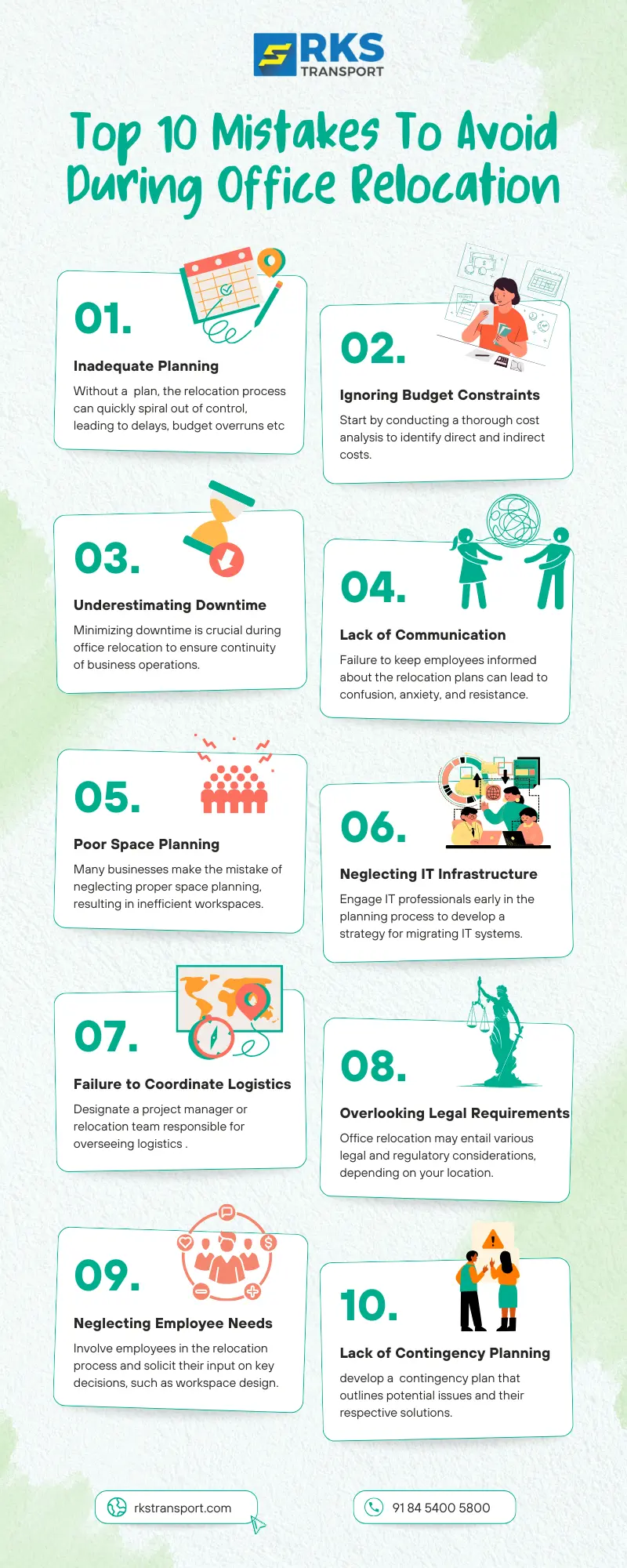Top 10 Mistakes To Avoid During Office Relocation | With Infographics/b>

Office relocation is a significant milestone for any business, signaling growth, expansion, or strategic realignment. However, the process of moving an entire office comes with its share of challenges, from logistical complexities to employee concerns. In the midst of packing boxes and coordinating logistics, it’s easy to overlook crucial details that could lead to costly mistakes. To ensure a seamless transition and minimize disruptions to daily operations, it’s essential to identify and avoid common pitfalls.
In this blog, we’ll explore the top 10 mistakes to avoid during office relocation, providing actionable insights to help businesses navigate the process with confidence and success.
Inadequate Planning:
Planning is the cornerstone of any successful office relocation. Yet, it’s a mistake many businesses overlook or underestimate. Without a comprehensive plan in place, the relocation process can quickly spiral out of control, leading to delays, budget overruns, and unnecessary stress. To avoid this mistake, start planning well in advance of the move date. Gather input from key stakeholders, including department heads, IT staff, and facilities management, to ensure all aspects of the relocation are considered. Establish clear objectives, such as space requirements, budget constraints, and timeline expectations. Create a detailed checklist of tasks and responsibilities, assigning roles to individuals or teams to oversee different aspects of the relocation process. Regularly review and update the relocation plan as needed to adapt to changing circumstances and mitigate potential risks.

Ignoring Budget Constraints:
Budget overruns are a common concern during office relocations, often resulting from inadequate cost estimation or unforeseen expenses. To avoid this mistake, it’s essential to develop a comprehensive budget that accounts for all expenses associated with the move. Start by conducting a thorough cost analysis to identify direct and indirect costs, including packing materials, transportation, and potential downtime. Factor in contingency funds to address unexpected expenses or changes in scope. Be sure to communicate budget constraints openly and transparently with all stakeholders to manage expectations and prioritize spending based on critical needs and strategic objectives.
Underestimating Downtime:
Minimizing downtime is crucial during office relocation to ensure continuity of business operations. However, many businesses underestimate the time required to complete the move and overlook the potential impact on productivity. To avoid this mistake, develop a realistic timeline that allows sufficient time for packing, transportation, and setup at the new location. Communicate with employees and clients about the relocation schedule well in advance to manage expectations and mitigate disruptions. Consider implementing temporary measures, such as remote work arrangements or alternative workspaces, to maintain essential operations during downtime.
Lack of Communication:
Effective communication is key to a successful office relocation, yet it’s a common area where businesses falter. According to research, 70% of business errors are due to improper communication. Failure to keep employees informed about the relocation plans can lead to confusion, anxiety, and resistance to change. To avoid this mistake, establish clear lines of communication and provide regular updates throughout the relocation process. Encourage feedback from employees and address any concerns or questions promptly to foster a sense of transparency and trust. Consider using multiple communication channels, such as email, meetings, intranet, and social media, to reach employees with diverse preferences and accessibility needs.

Poor Space Planning:
Moving to a new office presents an opportunity to optimize your workspace layout and improve efficiency. However, many businesses make the mistake of neglecting proper space planning, resulting in cramped, inefficient, or underutilized workspaces. Before the move, assess your space requirements and consider factors such as workflow, collaboration needs, and future growth projections. Invest in ergonomic furniture and design solutions that enhance productivity and employee well-being. Create a detailed floor plan that reflects the needs and priorities of your organization, including designated areas for individual work, team collaboration, meetings, and common areas. Allocate space efficiently based on functional requirements, traffic flow, and occupancy levels to maximize productivity and minimize wasted space.
Neglecting IT Infrastructure:
In today’s digital age, a smooth transition of IT infrastructure is essential for business continuity during office relocation. Unfortunately, many businesses overlook this critical aspect and encounter technical issues that disrupt operations. To avoid this mistake, engage IT professionals early in the planning process to assess your current setup and develop a strategy for migrating IT systems, networks, and equipment to the new location. Test all systems thoroughly before the move to identify and address any potential issues. Develop a comprehensive plan for transferring data, setting up networks, and configuring hardware and software at the new location. Communicate with employees about changes to IT systems and provide training and support as needed to ensure a smooth transition.
Failure to Coordinate Logistics:
Coordinating the office relocation services involves a myriad of tasks, from arranging transportation to coordinating schedules with vendors and service providers. Without proper coordination, delays and disruptions are inevitable. To prevent this mistake, designate a project manager or relocation team responsible for overseeing logistics and coordinating all aspects of the move. Develop a detailed timeline and checklist of tasks, and ensure clear communication among all parties involved. Coordinate closely with packers and movers in Coimbatore to secure necessary resources, such as moving trucks, packing materials, and temporary storage facilities. Communicate regularly with all stakeholders to provide updates, address concerns, and resolve issues as they arise.

Overlooking Legal and Regulatory Requirements:
Office relocation may entail various legal and regulatory considerations, depending on your industry and location. Failure to comply with these requirements can result in costly fines or legal issues down the line. Before the move, research applicable regulations related to zoning, permits, licenses, and safety standards. Consult legal experts or regulatory agencies to ensure compliance and address any potential issues proactively. Obtain necessary permits and approvals well in advance of the move to avoid delays or disruptions due to legal issues. Communicate openly and transparently with all stakeholders about legal and regulatory requirements, and address any concerns or questions promptly to ensure compliance and minimize risk.
Neglecting Employee Needs:
Employees are the lifeblood of any organization, and their well-being should be a top priority during office relocation. Unfortunately, many businesses overlook the impact of the move on their workforce and fail to address employee needs adequately. To avoid this mistake, involve employees in the relocation process and solicit their input on key decisions, such as workspace design and amenities. Provide support and resources to help employees adapt to the change, such as relocation assistance and ergonomic training. Communicate openly and transparently with employees about the reasons for the relocation and the expected impact on their roles, responsibilities, and work environment. Address any concerns or issues raised by employees promptly and transparently to build trust and confidence in the relocation process.
Read our blog on “ How To Keep Your Team Motivated While Shifting To New Office?” for more information about handling employees during office shifting.
Lack of Contingency Planning:
No matter how well you plan, unexpected challenges can arise during office relocation. Failure to anticipate and plan for these contingencies can derail the entire move and lead to costly delays. To mitigate this risk, develop a comprehensive contingency plan that outlines potential issues and their respective solutions. Identify key stakeholders and resources responsible for implementing the contingency plan and ensure clear communication channels are in place to address any emergencies promptly. Regularly review and update the contingency plan as needed to adapt to changing circumstances and emerging threats. Conduct drills and exercises to test the effectiveness of the contingency plan and familiarize employees with emergency procedures.
Conclusion:
Office relocation is a complex process that requires careful planning, coordination, and execution to ensure a smooth transition for your organization. By avoiding the common mistakes outlined in this guide and following best practices, you can minimize disruptions and maximize the success of your relocation project. Remember to prioritize thorough planning, effective communication, and employee engagement throughout the relocation process to set the stage for long-term success in your new office space. With proper preparation and execution, your office relocation can be a seamless experience that propels your business forward into the future.




